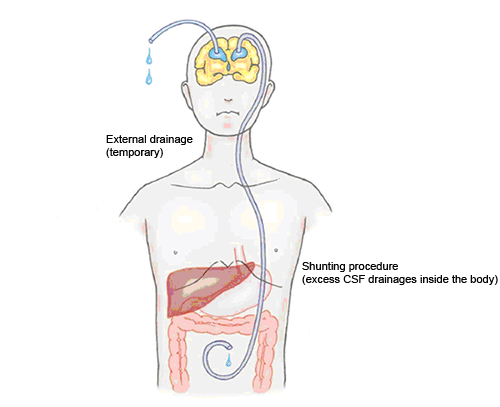- HOME
- For Patients
- Hydrocephalus
- Treatment of hydrocephalus
Hydrocephalus
- About hydrocephalus
- Symptom of hydrocephalus
- Cause of hydrocephalus
- Diagnosis of hydrocephalus
- Treatment of hydrocephalus
- Endoscopic surgery of the hydrocephalus
Treatment of hydrocephalus
The cause and nature of the hydrocephalus are the most important factors in choosing the method of treatment
Regardless of the cause of hydrocephalus and whether it is congenital or acquired, it is crucial to determine the rate of progression (how fast the condition is changing). In acquired hydrocephalus, a treatment method is selected by taking into account whether the cause is treatable and the hydrocephalus is only a temporary condition or whether it is permanent, as well as the severity of both the underlying disorder and the hydrocephalus itself. Treatment for hydrocephalus itself comprises both temporary (emergency) and permanent treatments. Temporary treatment is usually carried out by a method called "ventricular drainage". This is a general term that refers to draining off some of the excess cerebrospinal fluid outside the cranium, with the goal of reducing pressure inside the head. Drainage is not necessary if the cause can be treated and the circulation of cerebrospinal fluid returns to normal. This treatment has the advantage of only taking a short time, and is performed to stabilize the condition if the underlying disorder cannot be treated immediately. Drainage is an emergency treatment that is performed to relieve instability due to sudden rises in pressure inside the head, whether congenital or acquired.
Permanent treatment is carried out if sufficient improvement cannot be obtained even when the cause of hydrocephalus has been eliminated, if hydrocephalus occurs after recovery from a disease, or if the cause is unknown. Two main types of permanent treatment are available.
Shunts
[ Treatment of hydrocephalus ]

M Matsumae. Understanding the tumor. Clinical study. Vol 29, No. 14, 2008
Medical Friend Co. Ltd. Illustrator Kitahara Isao
Shunts are performed in both children and adults, regardless of age and the cause of hydrocephalus. A fine tube called a "shunt tube" is used to drain off part of the original flow of cerebrospinal fluid to another part of the body outside the head. Normally, a ventriculo-peritoneal shunt (draining into the abdomen) or a ventriculo-atrial shunt (draining directly into the bloodstream via the atrium of the heart) is used. This is an excellent method of treatment that is reliably effective, and a number of different arrangements have been devised to counteract the various disadvantages. These are used in different ways depending on the age of the patient, the cause of hydrocephalus, and the type of condition. The other shunt method is called lumbo-peritoneal shunt. This shunt method involves placement of a shunt tube near the spinal cord in the lower back (lumbar region), and drainage of excess cerebrospinal fluid into the abdomen. Lumbo-peritoneal shunt is suitable for the type of adult-onset hydrocephalus called NPH or iNPH.







